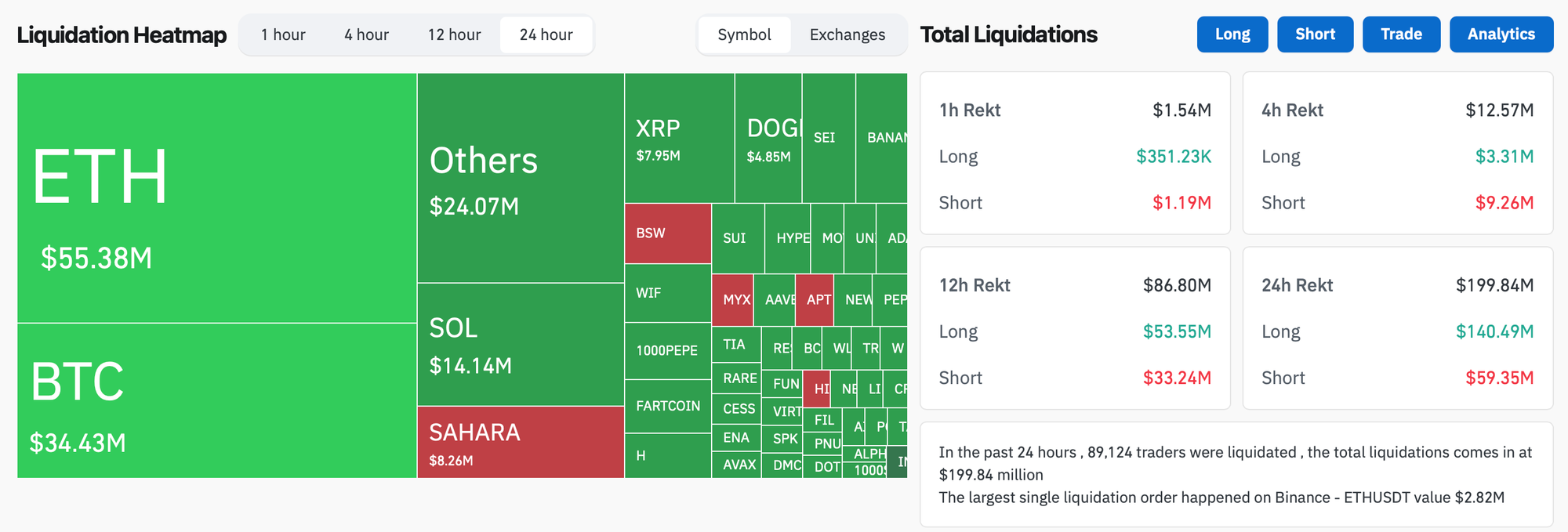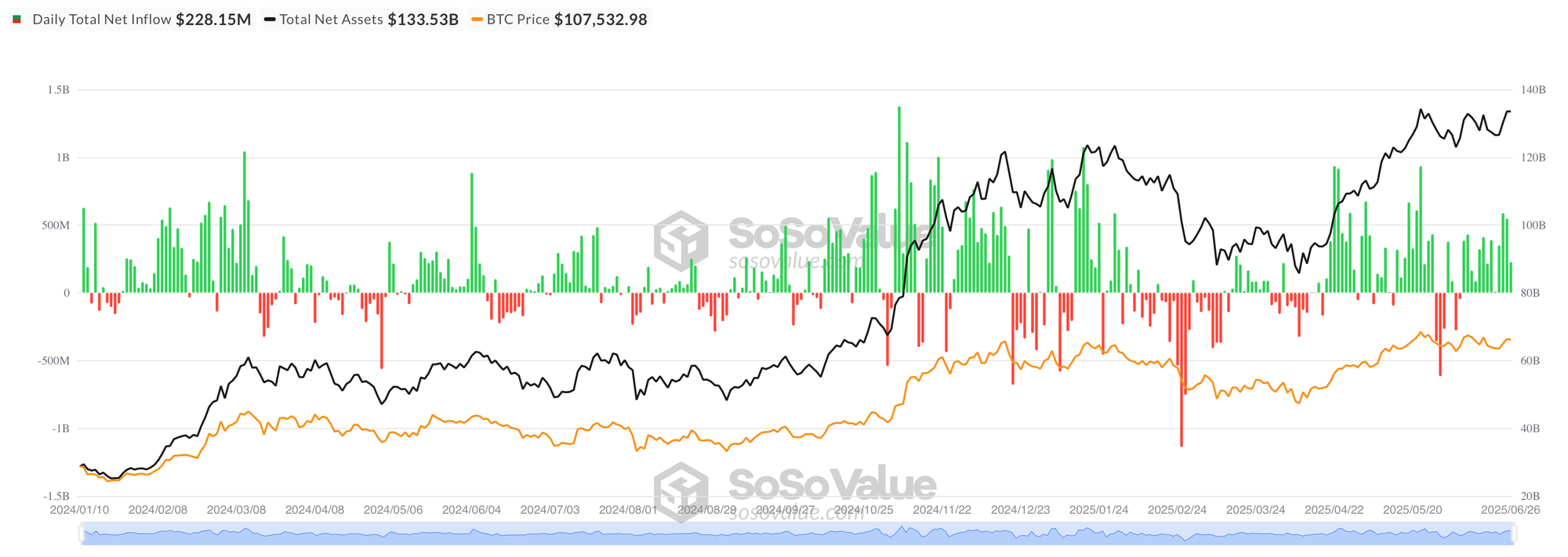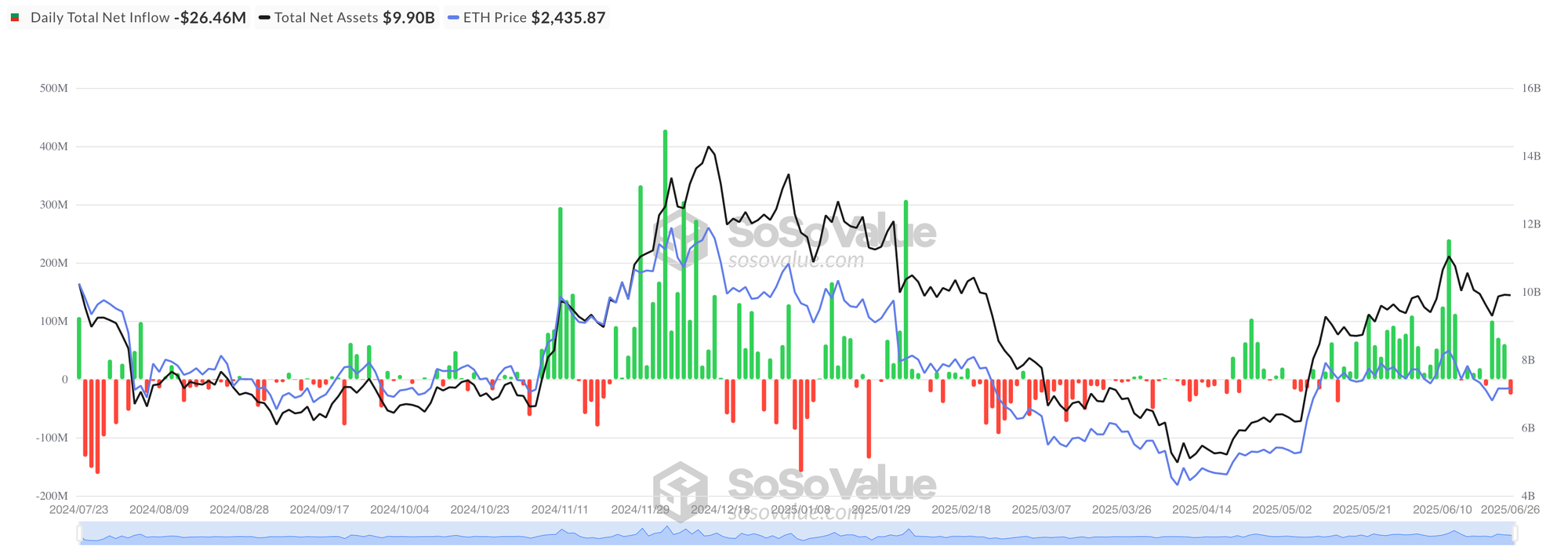
Global markets rose as trade tensions eased, with the Dow Jones (+0.94%), S&P 500 (+0.8%), and Nasdaq (+0.97%) all gaining. President Trump announced a trade truce with China, sparking optimism. However, concerns over the US debt load and inflation led to an exodus from long-term bonds, with investors fleeing at the fastest rate since the Covid-19 pandemic. The US goods exports also tumbled, highlighting the distortion caused by Trump’s tariffs. Meanwhile, the ECB noted it had beaten inflation without heavy economic costs, and the UK vehicle production hit a 76-year low due to tariffs.
- The global crypto market cap decreased 0.7% in the past 24 hours to $3.28tn. The total crypto market 24h volume decreased 10% to $99bn.
- In the past 24 hours, crypto liquidations decreased by 14% and totaled $199m, with 70% of them long positions. ETH positions made up over 27.7% of all liquidated positions.

- According to data from SoSo Value, Bitcoin ETFs recorded $228.2 million in net inflows on June 26, representing a significant slowdown from the previous day’s $547.7 million as institutional appetite moderated after several days of heavy buying. BlackRock’s IBIT continued to dominate with $163.7 million in inflows, accounting for over 70% of the day’s total, while Fidelity’s FBTC contributed $32.9 million and Bitwise’s BITB added $25.2 million. Grayscale’s GBTC recorded zero flows for the third consecutive day, suggesting the major redemption cycle has stabilized. All Bitcoin ETFs traded slightly lower, declining around 0.2% as the cryptocurrency pulled back, with total assets holding steady at $133.5 billion and cumulative net inflows reaching $48.4 billion. Despite the deceleration, the ETFs have still attracted over $1.8 billion in the past four trading days, underscoring sustained institutional demand.
- According to data from SoSo Value, Ethereum ETFs experienced their first net outflows in several days on June 26, recording -$26.5 million as Grayscale’s products dominated selling despite modest inflows elsewhere. Grayscale’s ETHE saw $27.5 million in outflows while its lower-fee ETH product had $12.4 million in redemptions, overwhelming the $5.9 million in inflows to BlackRock’s ETHA and smaller contributions from Fidelity’s FETH ($4.9 million) and Bitwise’s ETHW ($2.6 million). The reversal marked a sharp contrast to the previous day’s $60.4 million in net inflows and continued a pattern of volatility that has characterized Ethereum ETF flows since launch. All ETH ETFs posted modest gains around 0.25%, with total assets holding steady at $9.90 billion and cumulative net inflows slipping to $4.10 billion. The renewed Grayscale outflows suggest the stability seen earlier in the week was temporary, highlighting ongoing challenges for Ethereum ETFs to match the consistent demand seen in their Bitcoin counterparts.


- AI-related blockchain activity has surged 86% in 2025, with 4.5 million daily unique active wallets now using AI decentralized apps, while funding for AI agent projects reached $1.39 billion, a 9.4% increase over 2024’s total, according to DappRadar. The growth has pushed AI’s market share from 9% at the start of the year to 19%, closing in on blockchain gaming’s leading 20% share of the DApp ecosystem. DappRadar analyst Sara Gherghelas said the surge reflects a “structural change” in how users engage with decentralized applications, with AI agents becoming “a new onchain interface layer” through DeFi copilots, social agents, and gaming assistants. Geographically, Europe accounts for 26% of trackable AI DApp users, followed by Asia at 22% and North America at 15.8%, with 33% from unspecified regions using VPNs or anonymized sources.
- Hong Kong introduced a comprehensive digital asset framework called “LEAP” on Thursday, implementing stablecoin licensing starting August 1 and unveiling plans to tokenize government bonds as the city positions itself as a global crypto hub. The government will “regularise the issuance of tokenized Government bonds” and promote tokenized ETFs while expanding tokenization across sectors including precious metals and renewable energy assets. Financial Secretary Paul Chan said the framework aims to integrate the real economy with social life, following recent approvals for spot crypto ETFs and staking services as Hong Kong prepares to introduce digital asset derivatives trading for professional investors.
- DeFi protocol Resupply lost $9.6 million in a price manipulation attack on Thursday, with an attacker exploiting a bug in the platform’s wstUSR market to drain funds using minimal collateral. Blockchain security firm Cyvers said the attacker, funded through Tornado Cash, manipulated the ResupplyPair contract to inflate share prices and borrow $10 million reUSD before converting the stolen funds to Ether and splitting them across two addresses. The exploit targeted Resupply’s integration with synthetic stablecoin cvcrvUSD, with Cyvers’ CTO Meir Dolev explaining that proper input validation and oracle checks could have prevented the attack. Resupply confirmed only its wstUSR market was affected and paused the impacted contracts, promising a full post-mortem analysis. The incident adds to a growing tally of crypto losses in 2025, with security firm CertiK reporting over $2.1 billion stolen through hacks and exploits this year as attackers increasingly shift tactics toward social engineering.
- Metaplanet has surpassed Tesla in corporate bitcoin holdings by buying 1,234 additional bitcoins, bringing its total to 12,345 bitcoins.
- World Liberty Financial, a Donald Trump-backed crypto venture, is preparing to publish its first stablecoin audit and may enable WLFI token transfers.
- Pi Network’s token surged 38% this week to a peak of $0.65 ahead of an expected artificial intelligence announcement, fueling speculation about a potential Google partnership. The rally began after Pi Network co-founder Nicolas Kokkalis appeared on a generative AI panel at Consensus 2025, with the company teasing answers at an event called Pi2Day.
